Picture this. There’s an attraction or event you’re looking forward to more than anything else during an upcoming vacation. You haven’t been there before or experienced it yet, but in your head, it’s going to be the best part of the trip–you just know it is.
Inevitably, the day of your visit to the sought after attraction arrives, but it’s somehow less than you expected. It’s not as dramatic as you had imagined. It doesn’t leave you with the impact you were hoping for. Nothing has changed about you–except now you feel let down.
Tara and I have had our share of these experiences during our travels. In one way or another, Tsukiji Fish Market, the downtown area of Prague, and our cruise excursion in Playa Del Carmen didn’t live up to the levels of hype we had built up in our heads. However, the wonder we felt at teamLabs Planet Tokyo was proof that sometimes the anticipation and excitement for a particular attraction is warranted. Here are some reasons why we think this art exhibit should be on anyone’s Tokyo itinerary.
No Shoes, No Socks, No Problem
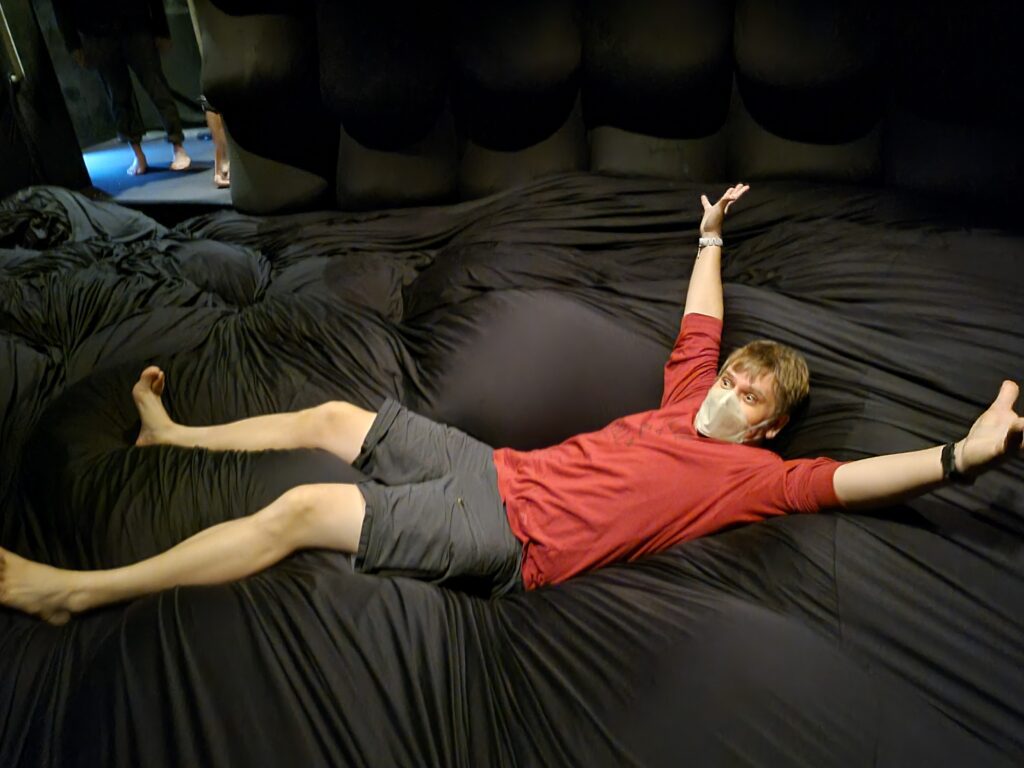

This was the first exhibit we’ve visited where we were instructed to take off our shoes and socks upon entry. Along with the removal of our footwear, we were also advised to roll up our pant legs because we “may encounter” knee-deep levels of water during our time at teamLab Planets Tokyo.
Barefoot and with exposed knees, we stepped into ankle-deep warm water in a darkened hallway. The only source of light were soft blue beams illuminating an undulating path on the water’s service. Each squishy step took us further away from the reality of the entrance and closer to the bizarre sensory adventure of the exhibit. This sensation was driven further home when we heard rushing water and encountered an incline with a spout of pounding water at the top causing a cascade of lukewarm water to run down the only path. After that squishy hike, we toweled off our feet, and entered a room full of…bean bag chair material?
Seriously, all of the walls and the floor of this room were covered in a lumpy black polyester material. The interior of these lumps felt like the squishy stuffing we’d normally associate with a bean bag chair. It was as if the entire room was stuffed. Moving from the entrance to the exit was nearly impossible to accomplish in an upright position. We managed to pull ourselves through and only became fully immersed in bead-fill material on a couple occasions, but we were in hysterics the entire time.
Light Speed But No Skirts
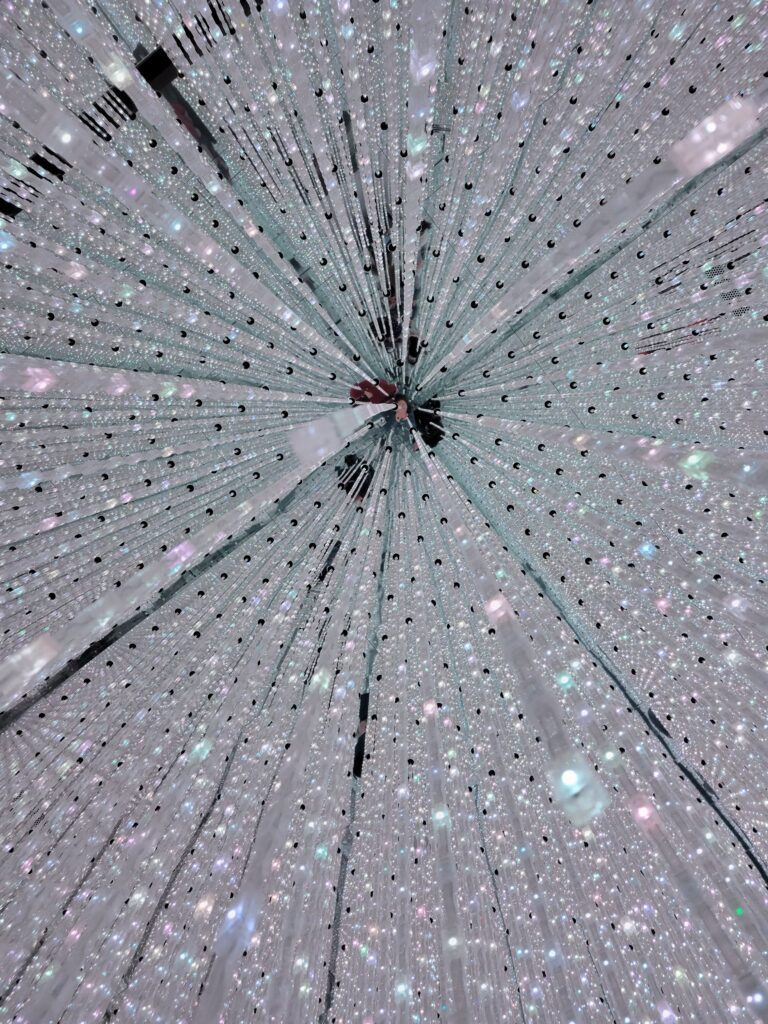

The next portion of the exhibit was hidden behind a dark curtain. We stepped through into the interior of a disco ball. Mirrors one very surface worked in tandem with flickering LED lights to create the illusion of movement. It was as if we were on the Millennium Falcon and Chewie had been instructed to punch the light speed controls.
When not being visually transported to the obliterated remnants that were once the planet of Alderaan, Tara and I gazed down at the floor or up at the ceiling to catch the infinite reflections of ourselves in the mirrored surfaces. It was similar to being in a room full of mirrors–but less fun house and more sparkly tessellations. We thoroughly enjoyed this room, but I could see how being susceptible to vertigo or having just a little bit to drink prior to your arrival would cause someone to have a less than stellar time in this part of the exhibit.
Pro tip: Unless you want to show off your unmentionables, don’t wear a skirt, dress, kilt, or any other non-individually-legged clothing item over the lower half of your body when visiting this exhibit!
Chasing Digital Fish
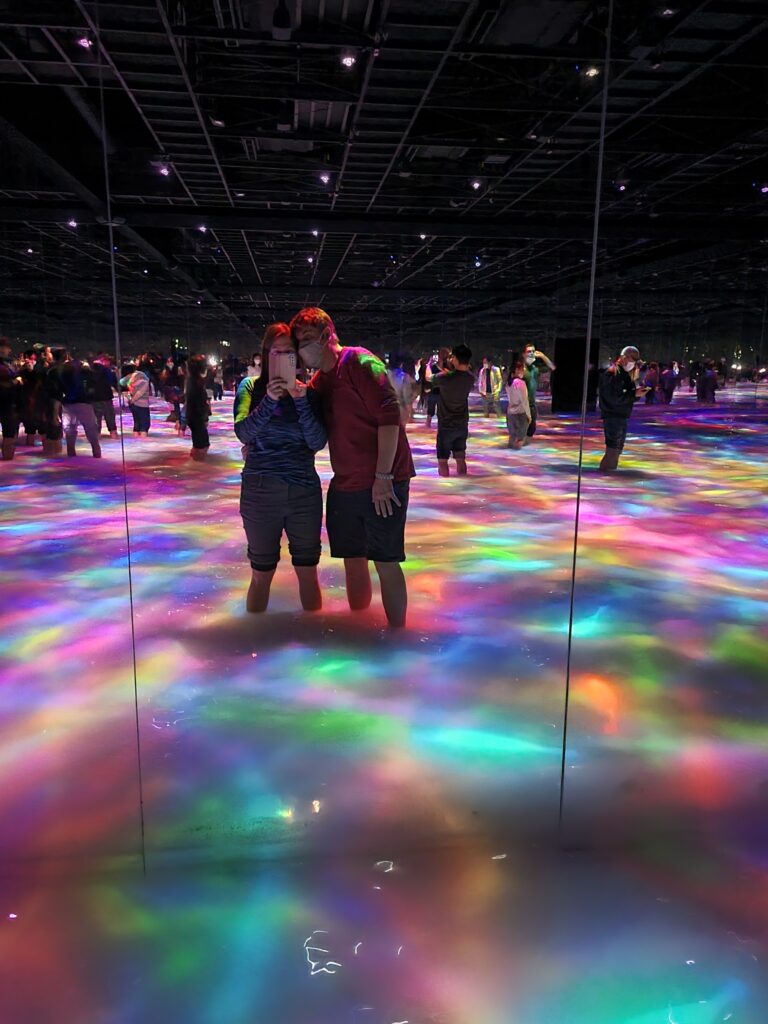

After spending time in light speed and looking at every angle of our bodies reflected back at us, we entered the water again. This time, it was slightly warmer and more opaque…two adjectives we normally don’t like to associate with a public body of water. However, this area of mid-shin level water was home to dozens and dozens of light projected fish.
Tara and I sloshed from one side of the room to another chasing neon green, blue, purple, and yellow koi fish in the milky, warm water. Initially, all of the fish darted in what appeared to be predetermined patterns around the room. Then they seemed to adapt. Some fish would retreat from our advances while others would almost curiously move around our ankles. We have no clue as to how this was accomplished. It was as if the laser-projected fish were connected to an obstacle sensor to process exactly when a fish’s path was being interrupted by a pesky carbon lifeform.
About ten minutes after we entered the room, all of the fish departed and were replaced with flower blossoms. Digital representations of cherry blossoms, chrysanthemums, irises, and lotuses replaced the inquisitive koi. Each flower swayed as if it was on the water’s surface. If we touched the water near one of the blossoms, its petals would spread out in all directions as if they were being carried off by an actual current.
Color Changing Lights and Balls
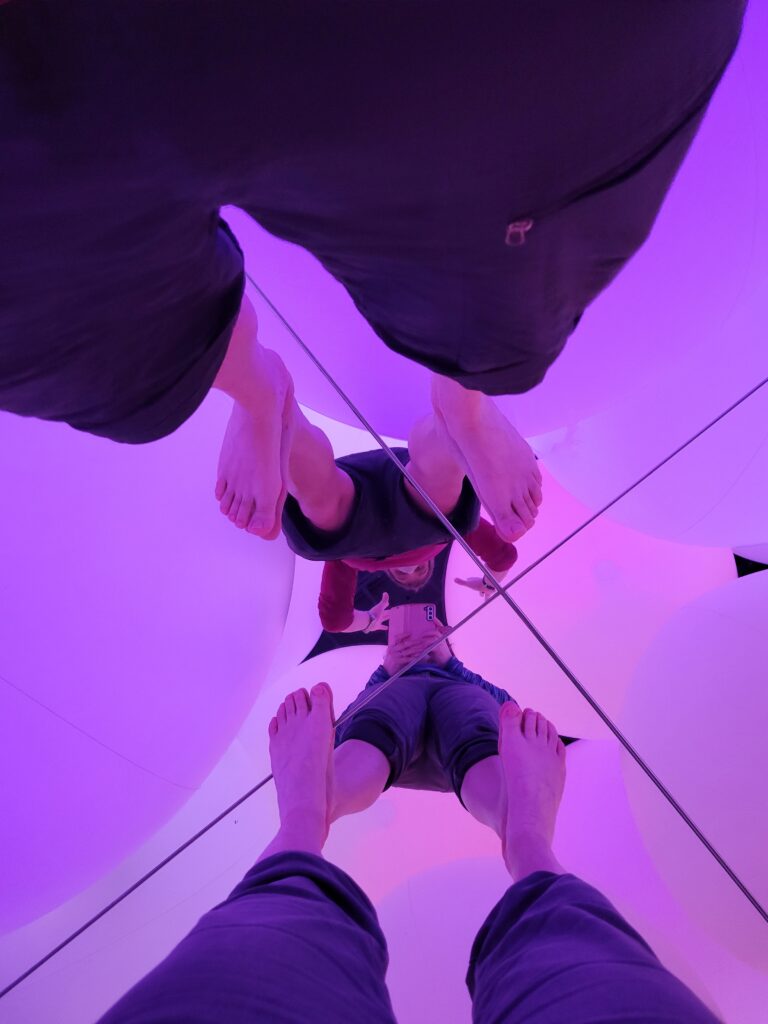

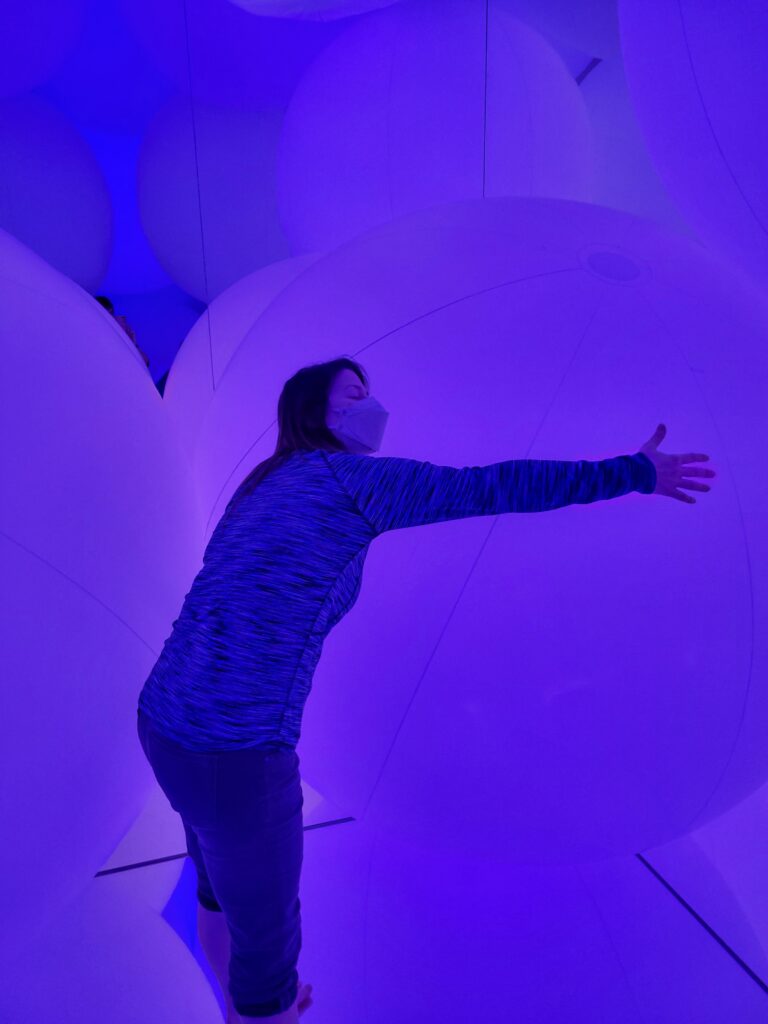

The theme of changing colors continued in the next segment of the exhibit. This time we weren’t chasing fish or watching flower petals disperse. Nope, this room was dedicated to giant (nearly six feet in circumference) balls that changed color with the lighting sequence in the room. Blue balls shifted to pink and so on through most of the colors in a rainbow.
Along with their color-changing appearance, the balls were light and semi-interactive. Tiny children raced around this room punching, kicking, tackling, or hugging these enormous playthings, and a light on the inside of the ball would flicker. Many of the kids squealed with joy as they lifted or pushed these dinosauric-sized orbs across the room.
More Than an Average Laser Show
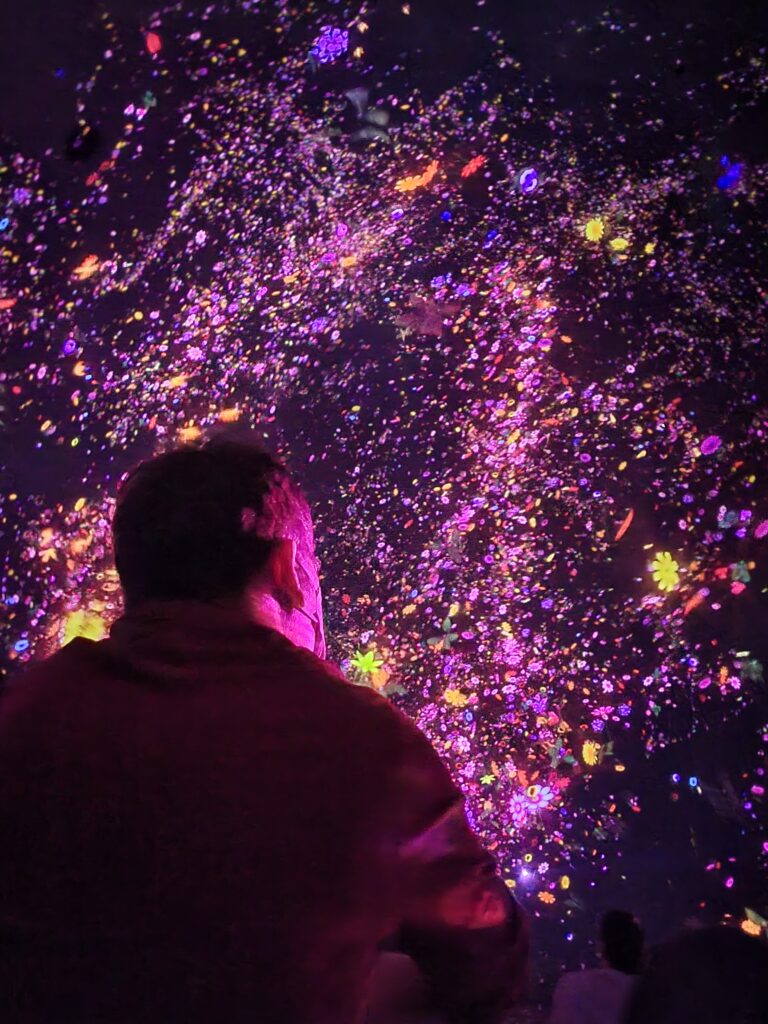

Flowers, leaves, and other natural patterns danced around this domed room’s curved ceiling and walls, and I was reminded of laser light shows I saw at the Pacific Science Center in downtown Seattle as a teenager. But instead of hearing a mashup of classic rock anthems and alternative music, our ears were treated to strings and wood instruments delivering touching swells and gentle notes synchronized perfectly with the patterns all around us.
It was an emotional experience to see the arrangement of falling objects slow and the music dim for the next movement. Something akin to watching a constellation fall, change, and surround you. Only these constellations were primarily composed of flowers.
Honestly, this was my favorite room in the entire building. I remember wanting to lay on the floor and stare up for hours on end. A feeling of being insignificant in the grand scheme of things but being completely okay with that.
Things to Know
- Tickets
- for adults are 3,200 yen (about $23.75)
- for teens are 2,000 yen (about $14.85)
- for preteens are 1,000 yen (about $7.43)
- Book your tickets in advance. You will receive a 30-minute arrival time with your booking
- Show up towards the beginning of your booking window to get ahead of the large line you will most likely encounter.
- Have some form of data on your phone. You will receive a digital copy of your tickets with your booking. You will need to show this digital copy to get into the exhibit. Screenshots will NOT be accepted. In a pinch, you can connect to their guest wifi.
- If you’re like us and arrive at Toyosu Station, come out of exit 7, walk underneath the elevated tram station, and keep walking straight for ten to fifteen minutes. You will eventually bump into teamLab on your right.
Thanks for reading! During your travels, what experience absolutely lived up to or surpassed its hype? Let us know in the comments below.
Remember: Life is short, so dig in!

Pingback: Top 5 Best Desserts in Tokyo - Tara and Luke Dig In